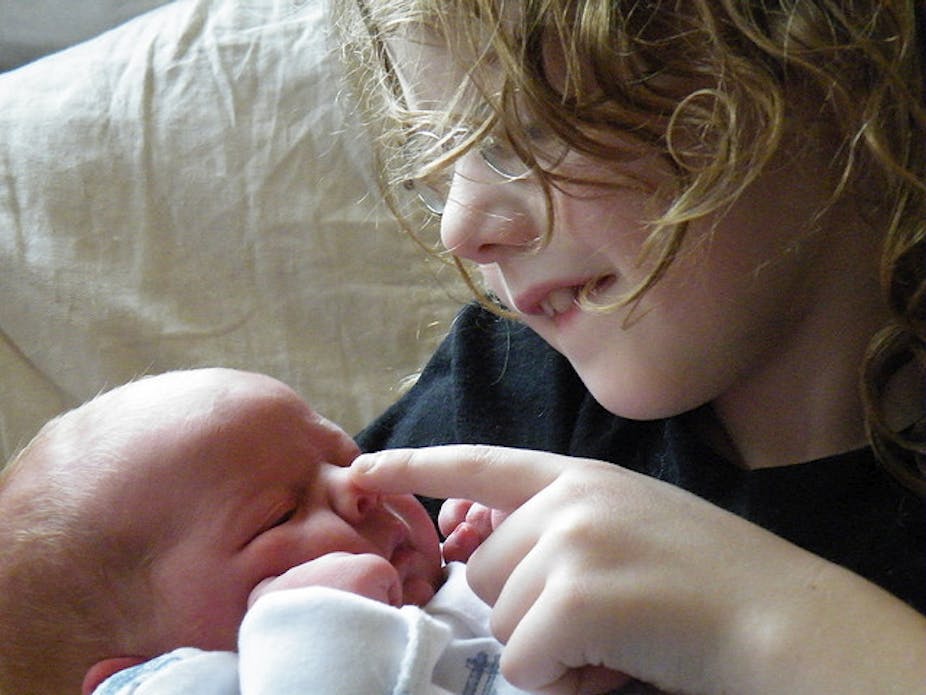A study published overnight in the journal Paediatrics shows the siblings of autistic children have a much higher risk of autism than previously thought. Nicole Rinehart, clinical psychologist and Associate Professor of Psychology at Monash University, explains the study’s significance:
The study shows the sibling recurrence of autism is much higher than previously thought, at around 19%.
This means that as clinicians, we need to more actively monitor siblings of children with autism and have that data available when we’re advising families of the risks of future children having autism.
This information gives power to parents to make more informed choices.
But the problem is that different families have different risk factors. So 19% is just an average – for some families the risk will be lower, for others it could be higher.
The research still isn’t at the place where we can be very specific about risk.
How do you expect this data will affect family planning discussions?
Essentially, when parents ask “what’s the risk?”, at the moment, we’re saying it’s around 9%. Now we know it’s more like 19% – that’s a big increase.
Do you expect it will deter parents of autistic children from having more kids?
Every family is individual and perceptions of autism and Asperger’s have changed markedly over the past decade.
When we assess children for autism, the first thing we do is take a family history and create a family tree to get a sense of the prevalence of the disorder.
Ten years ago we might’ve had parents talk about a family member who lived at home until they were 40, never married and was a bit socially reclusive.
But now, families are much more aware of Asperger’s disorder and when we do the family trees, the parents offer sophisticated family histories.
So, as more information on autism and Asperger’s becomes available, families put more thought into these issues.
I’ve seen a couple of families this week who went on to have a child very mindful of their family history. So things have changed.
How has our understanding about the role of genetics and environment in autism changed?
We know it’s a genetic.
But historically, in the 1950s and 1960s, we went through a terrible time where parents of children who were diagnosed with autism were told they somehow caused it – for instance because they were a cold and unloving mother, they caused their child to be socially shut off and have delayed language abilities.
That was called the “refrigerator parent era”.
In the 1970s, scientist Bernard Rimland had a son with autism and was one of the early people to put forward the argument that autism was a genetic disorder and was not caused by bad parenting.
From then on, science, psychiatry and psychology have come a long way in understanding the genetic basis of autism. We also have a lot of technology with which we can measure (and understand) different sorts of brain patterns and to define these as genetically caused disorders of the brain.
Because this was such a black mark in history for autism and science has really been dominated by neuroscience in the last couple of decades – looking at the “nature” or genetic contribution – we don’t know much about the contribution of “nurture” to the diagnosis of autistic-like symptoms.
What impact is this study likely to have on autism diagnostics?
It will mean that children are monitored from a much earlier stage.
The paper is saying we need to come up with a proactive plan to monitor siblings of children with autism. So if they are in this at-risk group and do have autism, they can be assessed earlier and receive early intervention, which is very important.
Is there a risk that these siblings could be over diagnosed?
This will always be a risk. It’s a bit like Asperger’s disorder now being talked about as “the new ADHD”. It seems like there are more diagnoses – and there are – and there will always be situations where a diagnosis could be wrong.
It’s therefore important that this data be used, managed and interpreted by highly experienced clinicians in the field.
What we don’t want to do is scare parents. We need to understand the data, understand that it is an overall average, and that there are families at greater risk and lesser risk. And we mustn’t be over-zealous in the way we monitor a sibling at risk of autism.
It’s now up to autism experts to determine how we take this information about the increased risk of autism among siblings and how we can appropriately monitor these siblings to ensure early detection and treatment of these disorders.
What tools are currently used to diagnose autism in the early years?
We have a range of diagnostic and screening tools available – and many have been designed for younger children – but at the end of the day, it’s clinical diagnosis and that’s what’s really important.
The diagnosis needs to be made by a clinician with a lot of expertise and we can’t throw batteries of tools at very young children.
Our research has looked at diagnosis of children as young as four and into early adulthood. We’re very interested in motor difficulties as markers of autism.
We see motor difficulties at a very young age and this manifests through development, affecting gait, hand writing, and everyday tasks we take for granted, such as being able to hold a cup.
With siblings, we might be able to come up with a sub-set of what we should be looking for and how early to begin looking – motor function would be an obvious thing to look at.

